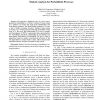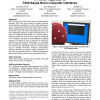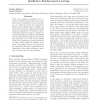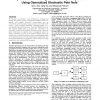LICS
2009
IEEE
15 years 2 months ago
2009
IEEE
—We associate a statistical vector to a trace and a geometrical embedding to a Markov Decision Process, based on a distance on words, and study basic Membership and Equivalence p...
IUI
2010
ACM
15 years 4 months ago
2010
ACM
Most of the previous work on non-invasive brain-computer interfaces (BCIs) has been focused on feature extraction and classification algorithms to achieve high performance for the...
PERCOM
2007
ACM
15 years 7 months ago
2007
ACM
We consider sensor scheduling as the optimal observability problem for partially observable Markov decision processes (POMDP). This model fits to the cases where a Markov process ...
ICML
2006
IEEE
15 years 8 months ago
2006
IEEE
How should a reinforcement learning agent act if its sole purpose is to efficiently learn an optimal policy for later use? In other words, how should it explore, to be able to exp...
ICML
2006
IEEE
15 years 8 months ago
2006
IEEE
For a Markov Decision Process with finite state (size S) and action spaces (size A per state), we propose a new algorithm--Delayed Q-Learning. We prove it is PAC, achieving near o...
ICML
2006
IEEE
15 years 8 months ago
2006
IEEE
When the transition probabilities and rewards of a Markov Decision Process are specified exactly, the problem can be solved without any interaction with the environment. When no s...
DAC
2000
ACM
15 years 8 months ago
2000
ACM
In this paper, we introduce a new technique for modeling and solving the dynamic power management (DPM) problem for systems with complex behavioral characteristics such as concurr...
103
click to vote
ICIP
2009
IEEE
15 years 8 months ago
2009
IEEE
We propose a robust approach for aligning lecture slides with lecture videos using a combination of Hough transform, optical flow and Gabor analysis. A Markov Decision Process mod...




